Indoor Air Quality Intervention in Schools: Effectiveness of a Portable HEPA Filter Deployment in Five Schools Impacted by Roadway and Aircraft Pollution Sources
Abstract
:1. Introduction
2. Materials and Methods
2.1. Study Area and Study Design
2.2. Portable Air Cleaner Selection
2.3. School Site Selection
2.4. Outdoor Air Exchange Rate
2.5. Air Quality Sampling and Analysis Methods
2.6. Estimating Average Infiltration
2.7. Statistical Anlaysis
3. Results
3.1. Outdoor Concentration
3.2. Observed Impact of HEPA Filter
3.3. Modeled Impact of HEPA Filter
3.4. Overall Distribution of Pollutants
3.5. Spatial Distribution of Flightpaths
4. Discussion
4.1. UFP Infiltration
4.2. HEPA Filtration Intervention
5. Conclusions
Supplementary Materials
Author Contributions
Funding
Institutional Review Board Statement
Data Availability Statement
Acknowledgments
Conflicts of Interest
Abbreviations
| AER | Air exchange rate |
| AHAM | Association of Home Appliance Manufacturers |
| AQS | Air Quality System |
| BC | Black carbon |
| BFI | Boeing Field |
| CADR | Clean air delivery rate |
| CFM | Cubic feet per minute |
| CPC | Condensation particle counter |
| FeNO | Fractional exhaled nitric oxide |
| HEPA | High-efficiency particulate air filter |
| MOV-UP | Mobile Observations of Ultrafine Particles |
| OSPI | Office of Superintendent of Public Instruction |
| RNT | Renton Municipal Airport |
| Sea-Tac | Seattle-Tacoma International Airport |
| SES | Socioeconomic |
| UFPs | Ultrafine particles |
| Ultra-UFPs | Ultra-ultrafine particles |
References
- Klepeis, N.E.; Nelson, W.C.; Ott, W.R.; Robinson, J.P.; Tsang, A.M.; Switzer, P.; Behar, J.V.; Hern, S.C.; Engelmann, W.H. The National Human Activity Pattern Survey (NHAPS): A resource for assessing exposure to environmental pollutants. J. Expo. Sci. Environ. Epidemiol. 2001, 11, 231–252. [Google Scholar] [CrossRef] [PubMed] [Green Version]
- Austin, E.; Xiang, J.; Gould, T.R.; Shirai, J.H.; Yun, S.; Yost, M.G.; Larson, T.V.; Seto, E. Distinct Ultrafine Particle Profiles Associated with Aircraft and Roadway Traffic. Environ. Sci. Technol. 2021, 55, 2847–2858. [Google Scholar] [CrossRef]
- Blanco, M.N.; Gassett, A.; Gould, T.; Doubleday, A.; Slager, D.L.; Austin, E.; Seto, E.; Larson, T.V.; Marshall, J.D.; Sheppard, L. Characterization of Annual Average Traffic-Related Air Pollution Concentrations in the Greater Seattle Area from a Year-Long Mobile Monitoring Campaign. Environ. Sci. Technol. 2022, 16, 11460–11472. [Google Scholar] [CrossRef] [PubMed]
- Westerdahl, D.; Fruin, S.; Sax, T.; Fine, P.M.; Sioutas, C. Mobile platform measurements of ultrafine particles and associated pollutant concentrations on freeways and residential streets in Los Angeles. Atmos. Environ. 2005, 39, 3597–3610. [Google Scholar] [CrossRef]
- Hudda, N.; Simon, M.; Zamore, W.; Durant, J.L. Aviation-Related Impacts on Ultrafine Particle Number Concentrations Outside and Inside Residences near an Airport. Environ. Sci. Technol. 2018, 52, 1765–1772. [Google Scholar] [CrossRef] [Green Version]
- Shirmohammadi, F.; Sowlat, M.H.; Hasheminassab, S.; Saffari, A.; Ban-Weiss, G.; Sioutas, C. Emission rates of particle number, mass and black carbon by the Los Angeles International Airport (LAX) and its impact on air quality in Los Angeles. Atmos. Environ. 2017, 151, 82–93. [Google Scholar] [CrossRef]
- Hudda, N.; Fruin, S.A. International Airport Impacts to Air Quality: Size and Related Properties of Large Increases in Ultrafine Particle Number Concentrations. Environ. Sci. Technol. 2016, 50, 3362–3370. [Google Scholar] [CrossRef]
- Riley, E.A.; Gould, T.; Hartin, K.; Fruin, S.A.; Simpson, C.D.; Yost, M.G.; Larson, T. Ultrafine particle size as a tracer for aircraft turbine emissions. Atmos. Environ. 2016, 139, 20–29. [Google Scholar] [CrossRef] [Green Version]
- Hudda, N.; Simon, M.; Zamore, W.; Brugge, D.; Durant, J.L. Aviation Emissions Impact Ambient Ultrafine Particle Concentrations in the Greater Boston Area. Environ. Sci. Technol. 2016, 50, 8514–8521. [Google Scholar] [CrossRef] [Green Version]
- Masiol, M.; Hopke, P.; Felton, H.; Frank, B.; Rattigan, O.; Wurth, M.; LaDuke, G. Analysis of major air pollutants and submicron particles in New York City and Long Island. Atmos. Environ. 2017, 148, 203–214. [Google Scholar] [CrossRef]
- Keuken, M.; Moerman, M.; Zandveld, P.; Henzing, J.; Hoek, G. Total and size-resolved particle number and black carbon concentrations in urban areas near Schiphol airport (The Netherlands). Atmos. Environ. 2015, 104, 132–142. [Google Scholar] [CrossRef]
- Larson, T.; Gould, T.; Riley, E.A.; Austin, E.; Fintzi, J.; Sheppard, L.; Yost, M.; Simpson, C. Ambient air quality measurements from a continuously moving mobile platform: Estimation of area-wide, fuel-based, mobile source emission factors using absolute principal component scores. Atmos. Environ. 2016, 152, 201–211. [Google Scholar] [CrossRef] [PubMed]
- Keller, J.P.; Larson, T.V.; Austin, E.; Barr, R.G.; Sheppard, L.; Vedal, S.; Kaufman, J.D.; Szpiro, A.A. Pollutant composition modification of the effect of air pollution on progression of coronary artery calcium. Environ. Epidemiol. 2018, 2, e024. [Google Scholar] [CrossRef] [PubMed]
- Thayer, K.L.; Lane, K.; Simon, M.C.; Brugge, D.; Fuller, C.H. An exploratory analysis of sociodemographic characteristics with ultrafine particle concentrations in Boston, MA. PLoS ONE 2022, 17, e0263434. [Google Scholar] [CrossRef]
- Elford, S.; Adams, M.D. Associations between socioeconomic status and ultrafine particulate exposure in the school commute: An environmental inequality study for Toronto, Canada. Environ. Res. 2020, 192, 110224. [Google Scholar] [CrossRef]
- Heinzerling, A.; Hsu, J.; Yip, F. Respiratory Health Effects of Ultrafine Particles in Children: A Literature Review. Water Air Soil Pollut. 2015, 227, 32. [Google Scholar] [CrossRef] [Green Version]
- García-Hernández, C.; Ferrero, A.; Estarlich, M.; Ballester, F. Exposure to ultrafine particles in children until 18 years of age: A systematic review. Indoor Air 2019, 30, 7–23. [Google Scholar] [CrossRef]
- Holm, S.M.; Miller, M.D.; Balmes, J.R. Health effects of wildfire smoke in children and public health tools: A narrative review. J. Expo. Sci. Environ. Epidemiology 2020, 31, 1–20. [Google Scholar] [CrossRef]
- Smoke from Fires | Washington State Department of Health. Available online: https://doh.wa.gov/community-and-environment/air-quality/smoke-fires (accessed on 16 September 2022).
- Thomas, E.G.; Wickramasinghe, K.; Mendis, S.; Roberts, N.; Foster, C. Improved stove interventions to reduce household air pollution in low and middle income countries: A descriptive systematic review. BMC Public Health 2015, 15, 650. [Google Scholar] [CrossRef] [Green Version]
- Kelly, F.J.; Fussell, J.C. Improving indoor air quality, health and performance within environments where people live, travel, learn and work. Atmos. Environ. 2018, 200, 90–109. [Google Scholar] [CrossRef]
- Lammers, A.; Janssen, N.; Boere, A.; Berger, M.; Longo, C.; Vijverberg, S.; Neerincx, A.; van der Zee, A.M.; Cassee, F. Effects of short-term exposures to ultrafine particles near an airport in healthy subjects. Environ. Int. 2020, 141, 105779. [Google Scholar] [CrossRef] [PubMed]
- Cheng, J.; Karambelkar, B.; Xie, Y.; Wickham, H.; Russell, K.; Johnson, K.; Schloerke, B.; Foundation, Q.; Agafonkin, V.; CloudMade; et al. Leaflet: Create Interactive Web Maps with the JavaScript ‘Leaflet’ Library. Mar. 23. 2022. Available online: https://CRAN.R-project.org/package=leaflet (accessed on 27 September 2022).
- Allen, J.; Spengler, J.; Jones, E.; Cedeno-Laurent, J. “5-step Guide to Checking Ventilation Rates in Classrooms.” Harvard Healthy Buildings Program, Aug. 2020. Available online: https://schools.forhealth.org/wp-content/uploads/sites/19/2020/08/Harvard-Healthy-Buildings-program-How-to-assess-classroom-ventilation-08-28-2020.pdf (accessed on 1 March 2021).
- Diapouli, E.; Chaloulakou, A.; Koutrakis, P. Estimating the concentration of indoor particles of outdoor origin: A review. J. Air Waste Manag. Assoc. 2013, 63, 1113–1129. [Google Scholar] [CrossRef] [PubMed]
- Sultan, Z.; Li, J.; Pantelic, J.; Schiavon, S. Indoor Air Pollution of Outdoor Origin: Mitigation Using Portable Air Cleaners in Singapore Office Building. Aerosol Air Qual. Res. 2022, 22, 220204. [Google Scholar] [CrossRef]
- Dowle, M.; Srinivasan, A.; Gorecki, J.; Chirico, M.; Stetsenko, P.; Short, T.; Lianoglou, S.; Antonyan, E.; Bonsch, M.; Parsonage, H.; et al. Data.Table: Extension of “Data.Frame”. 2019. Available online: https://CRAN.R-project.org/package=data.table (accessed on 31 March 2021).
- ggplot2—Wickham—2011—WIREs Computational Statistics—Wiley Online Library. Available online: https://wires.onlinelibrary.wiley.com/doi/full/10.1002/wics.147 (accessed on 30 June 2022).
- Searle, S.R.; Speed, F.M.; Milliken, G.A. Population Marginal Means in the Linear Model: An Alternative to Least Squares Means. Am. Stat. 1980, 34, 216. [Google Scholar] [CrossRef]
- Zeileis, A.; Grothendieck, G. zoo: S3 Infrastructure for Regular and Irregular Time Series. J. Stat. Softw. 2005, 14, 1–27. [Google Scholar] [CrossRef] [Green Version]
- Revelle, W. psych: Procedures for Psychological, Psychometric, and Personality Research. Northwestern University. 2021. Available online: https://CRAN.R-project.org/package=psych (accessed on 31 March 2021).
- Bernaards, C.A.; Jennrich, R.I. Gradient Projection Algorithms and Software for Arbitrary Rotation Criteria in Factor Analysis. Educ. Psychol. Meas. 2005, 65, 676–696. [Google Scholar] [CrossRef]
- Wickham, H.; François, R.; Müller, K. dplyr: A Grammar of Data Manipulation. Available online: https://CRAN.R-project.org/package=dplyr (accessed on 31 March 2021).
- Saha, P.K.; Hankey, S.; Marshall, J.D.; Robinson, A.L.; Presto, A.A. High-Spatial-Resolution Estimates of Ultrafine Particle Concentrations across the Continental United States. Environ. Sci. Technol. 2021, 55, 10320–10331. [Google Scholar] [CrossRef]
- Karumanchi, S.; Siemiatycki, J.; Richardson, L.; Hatzopoulou, M.; Lequy, E. Spatial and temporal variability of airborne ultrafine particles in the Greater Montreal area: Results of monitoring campaigns in two seasons. Sci. Total Environ. 2021, 771, 144652. [Google Scholar] [CrossRef]
- Kerckhoffs, J.; Hoek, G.; Gehring, U.; Vermeulen, R. Modelling nationwide spatial variation of ultrafine particles based on mobile monitoring. Environ. Int. 2021, 154, 106569. [Google Scholar] [CrossRef]
- Li, H.Z.; Gu, P.; Ye, Q.; Zimmerman, N.; Robinson, E.S.; Subramanian, R.; Apte, J.; Robinson, A.L.; Presto, A.A. Spatially dense air pollutant sampling: Implications of spatial variability on the representativeness of stationary air pollutant monitors. Atmos. Environ. X 2019, 2, 100012. [Google Scholar] [CrossRef]
- Patton, A.P.; Perkins, J.; Zamore, W.; Levy, J.I.; Brugge, D.; Durant, J.L. Spatial and temporal differences in traffic-related air pollution in three urban neighborhoods near an interstate highway. Atmos. Environ. 2014, 99, 309–321. [Google Scholar] [CrossRef] [PubMed] [Green Version]
- Simon, M.C.; Hudda, N.; Naumova, E.N.; Levy, J.I.; Brugge, D.; Durant, J.L. Comparisons of traffic-related ultrafine particle number concentrations measured in two urban areas by central, residential, and mobile monitoring. Atmos. Environ. 2017, 169, 113–127. [Google Scholar] [CrossRef] [PubMed]
- Saha, P.K.; Zimmerman, N.; Malings, C.; Hauryliuk, A.; Li, Z.; Snell, L.; Subramanian, R.; Lipsky, E.; Apte, J.; Robinson, A.; et al. Quantifying high-resolution spatial variations and local source impacts of urban ultrafine particle concentrations. Sci. Total Environ. 2018, 655, 473–481. [Google Scholar] [CrossRef]
- Mullen, N.A.; Bhangar, S.; Hering, S.V.; Kreisberg, N.M.; Nazaroff, W.W. Ultrafine particle concentrations and exposures in six elementary school classrooms in northern California. Indoor Air 2010, 21, 77–87. [Google Scholar] [CrossRef]
- Weichenthal, S.; Dufresne, A.; Infante-Rivard, C.; Joseph, L. Characterizing and predicting ultrafine particle counts in Canadian classrooms during the winter months: Model development and evaluation. Environ. Res. 2008, 106, 349–360. [Google Scholar] [CrossRef]
- Rivas, I.; Viana, M.; Moreno, T.; Bouso, L.; Pandolfi, M.; Alvarez-Pedrerol, M.; Forns, J.; Alastuey, A.; Sunyer, J.; Querol, X. Outdoor infiltration and indoor contribution of UFP and BC, OC, secondary inorganic ions and metals in PM2.5 in schools. Atmos. Environ. 2015, 106, 129–138. [Google Scholar] [CrossRef]
- Riederer, A.M.; Krenz, J.E.; Tchong-French, M.I.; Torres, E.; Perez, A.; Younglove, L.R.; Jansen, K.L.; Hardie, D.C.; Farquhar, S.A.; Sampson, P.D.; et al. Effectiveness of portable HEPA air cleaners on reducing indoor PM 2.5 and NH 3 in an agricultural cohort of children with asthma: A randomized intervention trial. Indoor Air 2020, 31, 454–466. [Google Scholar] [CrossRef] [PubMed]
- Lanphear, B.P.; Hornung, R.W.; Khoury, J.; Yolton, K.; Lierl, M.; Kalkbrenner, A. Effects of HEPA Air Cleaners on Unscheduled Asthma Visits and Asthma Symptoms for Children Exposed to Secondhand Tobacco Smoke. Pediatrics 2011, 127, 93–101. [Google Scholar] [CrossRef] [Green Version]
- James, C.; Bernstein, D.I.; Cox, J.; Ryan, P.; Wolfe, C.; Jandarov, R.; Newman, N.; Indugula, R.; Reponen, T. HEPA filtration improves asthma control in children exposed to traffic-related airborne particles. Indoor Air 2019, 30, 235–243. [Google Scholar] [CrossRef]
- Drieling, R.L.; Sampson, P.D.; Krenz, J.E.; French, M.I.T.; Jansen, K.L.; Massey, A.E.; Farquhar, S.A.; Min, E.; Perez, A.; Riederer, A.M.; et al. Randomized trial of a portable HEPA air cleaner intervention to reduce asthma morbidity among Latino children in an agricultural community. Environ. Health 2022, 21, 1. [Google Scholar] [CrossRef]
- Yang, X.; Wang, Q.; Han, F.; Dong, B.; Wen, B.; Li, L.; Ruan, H.; Zhang, S.; Kong, J.; Zhi, H.; et al. Pulmonary Benefits of Intervention with HEPA Air Purifier in Schoolchildren: A Double-Blind Crossover Study. Soc. Sci. Res. Netw. 2021, 2021, 3790393. [Google Scholar] [CrossRef]
- Curtius, J.; Granzin, M.; Schrod, J. Testing mobile air purifiers in a school classroom: Reducing the airborne transmission risk for SARS-CoV-2. Aerosol Sci. Technol. 2021, 55, 586–599. [Google Scholar] [CrossRef]
- Phipatanakul, W.; Koutrakis, P.; Coull, B.A.; Petty, C.R.; Gaffin, J.M.; Sheehan, W.J.; Lai, P.S.; Bartnikas, L.M.; Kang, C.-M.; Wolfson, J.M.; et al. Effect of School Integrated Pest Management or Classroom Air Filter Purifiers on Asthma Symptoms in Students with Active Asthma: A Randomized Clinical Trial. JAMA 2021, 326, 839–850. [Google Scholar] [CrossRef] [PubMed]
- Choe, Y.; Shin, J.-S.; Park, J.; Kim, E.; Oh, N.; Min, K.; Kim, D.; Sung, K.; Cho, M.; Yang, W. Inadequacy of air purifier for indoor air quality improvement in classrooms without external ventilation. Build. Environ. 2021, 207, 108450. [Google Scholar] [CrossRef]
- Polidori, A.; Fine, P.M.; White, V.; Kwon, P.S. Pilot study of high-performance air filtration for classroom applications. Indoor Air 2012, 23, 185–195. [Google Scholar] [CrossRef]
- McCarthy, M.C.; Ludwig, J.F.; Brown, S.G.; Vaughn, D.L.; Roberts, P.T. Filtration effectiveness of HVAC systems at near-roadway schools. Indoor Air 2013, 23, 196–207. [Google Scholar] [CrossRef]
- Duill, F.F.; Schulz, F.; Jain, A.; Krieger, L.; van Wachem, B.; Beyrau, F. The Impact of Large Mobile Air Purifiers on Aerosol Concentration in Classrooms and the Reduction of Airborne Transmission of SARS-CoV-2. Int. J. Environ. Res. Public Health 2021, 18, 11523. [Google Scholar] [CrossRef]
- Smythe, A. “Effectiveness of Particle Air Purifiers in Improving the Air Quality.” Harvard Library. 2018. Available online: http://nrs.harvard.edu/urn-3:HUL.InstRepos:37945127 (accessed on 1 March 2021).
- Basińska, M.; Michałkiewicz, M.; Ratajczak, K. Effect of Air Purifier Use in the Classrooms on Indoor Air Quality—Case Study. Atmosphere 2021, 12, 1606. [Google Scholar] [CrossRef]
- Pacitto, A.; Amato, F.; Moreno, T.; Pandolfi, M.; Fonseca, A.; Mazaheri, M.; Stabile, L.; Buonanno, G.; Querol, X. Effect of ventilation strategies and air purifiers on the children’s exposure to airborne particles and gaseous pollutants in school gyms. Sci. Total Environ. 2019, 712, 135673. [Google Scholar] [CrossRef]
- Brugge, D.; Simon, M.C.; Hudda, N.; Zellmer, M.; Corlin, L.; Cleland, S.; Lu, E.Y.; Rivera, S.; Byrne, M.; Chung, M.; et al. Lessons from in-home air filtration intervention trials to reduce urban ultrafine particle number concentrations. Build. Environ. 2017, 126, 266–275. [Google Scholar] [CrossRef]
- Zweig, J.; Ham, J.C.; Avol, E.L. “Air Pollution and Academic Performance: Evidence from California Schools,” Dec. 2009. Available online: https://citeseerx.ist.psu.edu/viewdoc/download?doi=10.1.1.614.3687&rep=rep1&type=pdf (accessed on 1 August 2022).
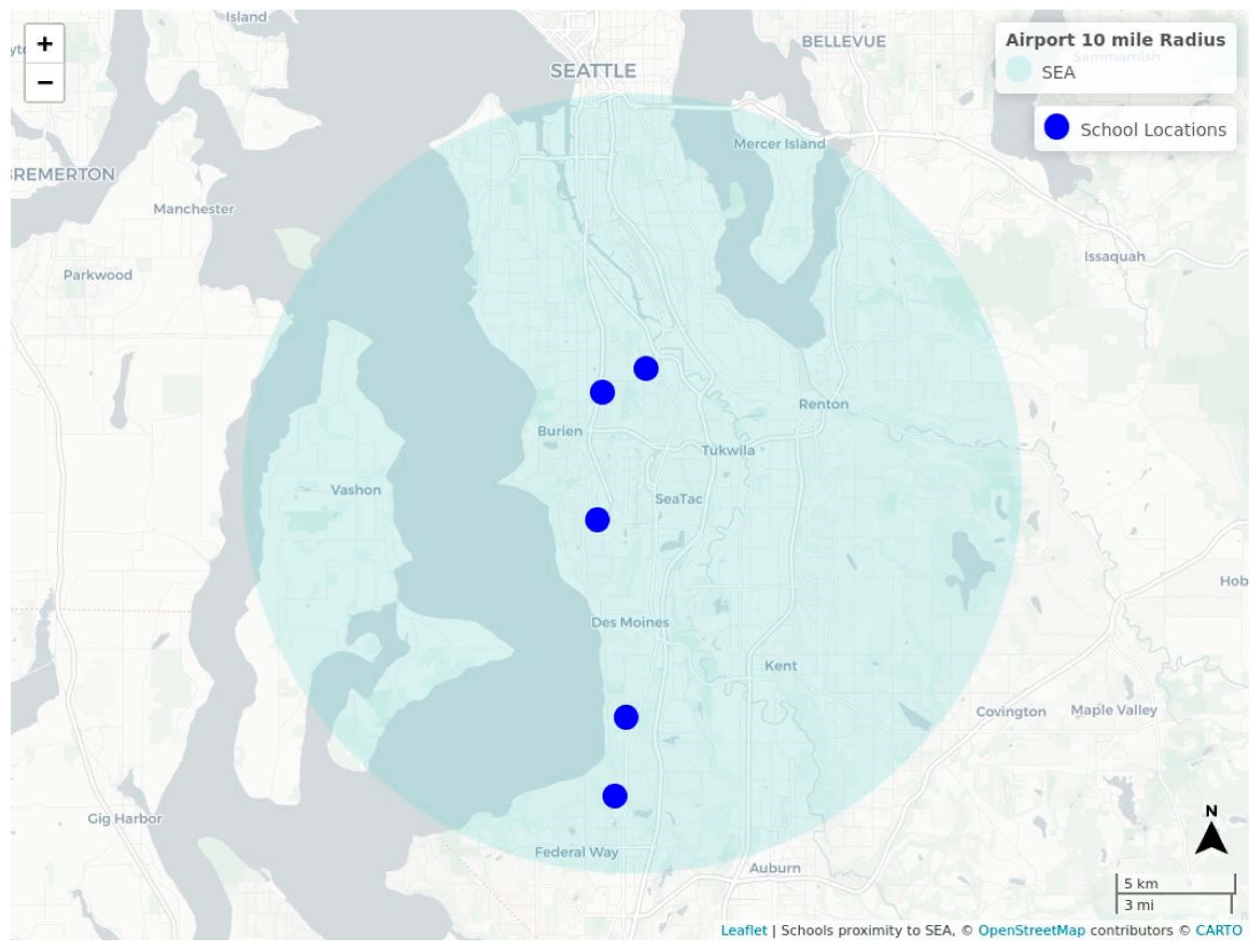

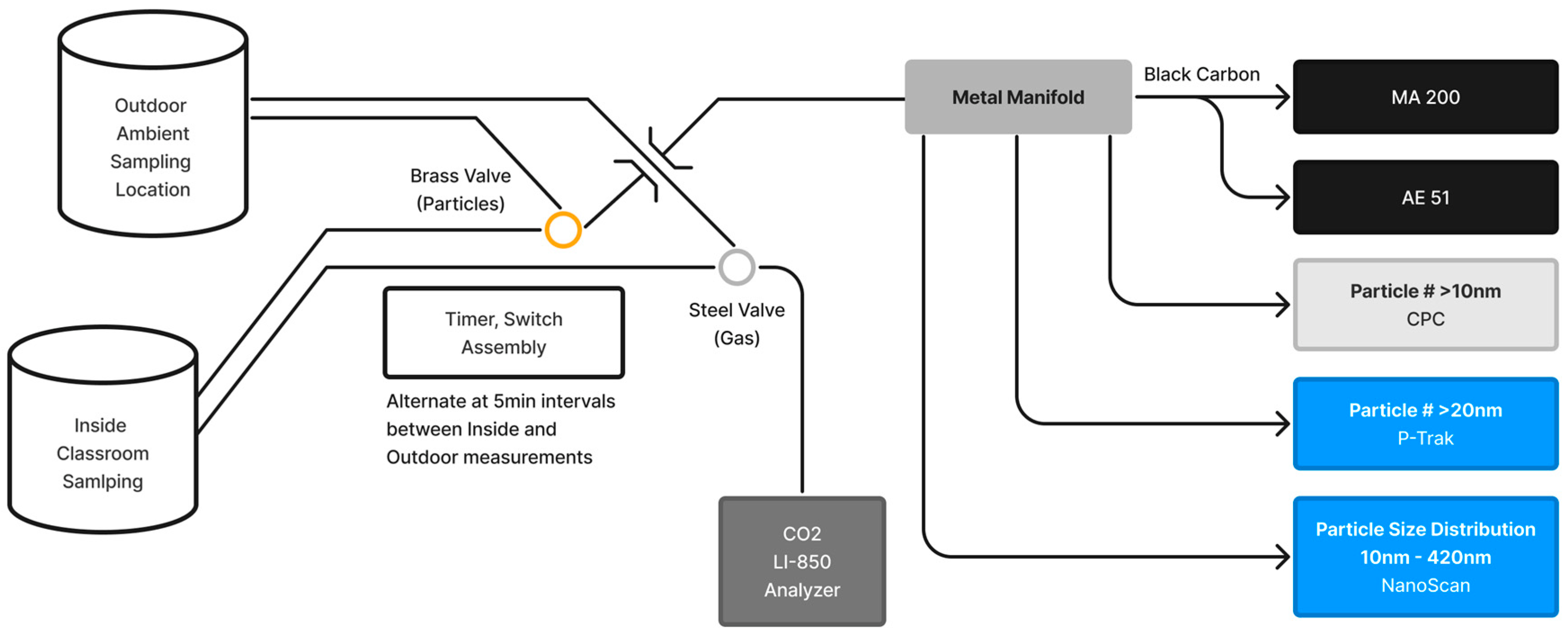
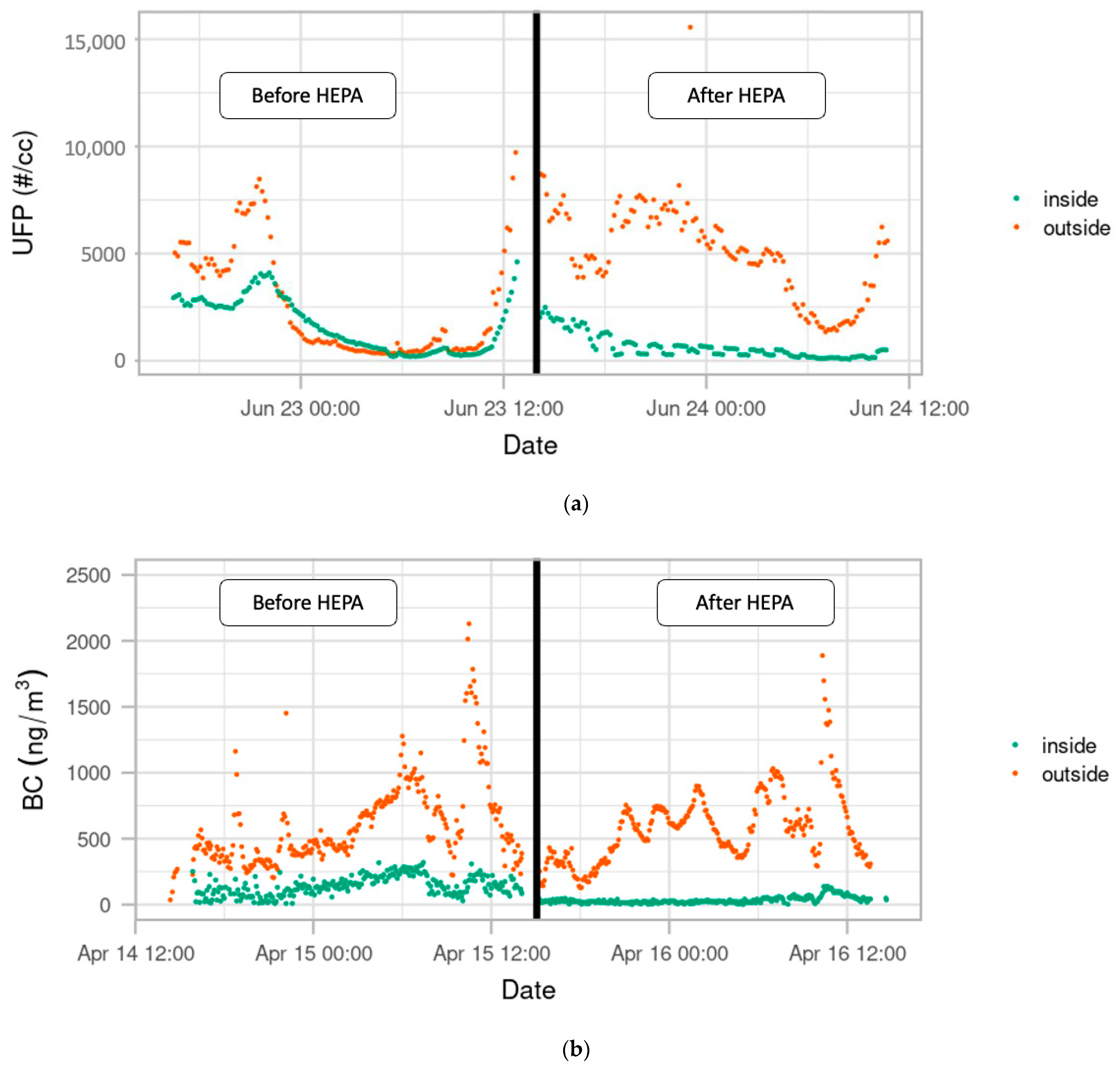

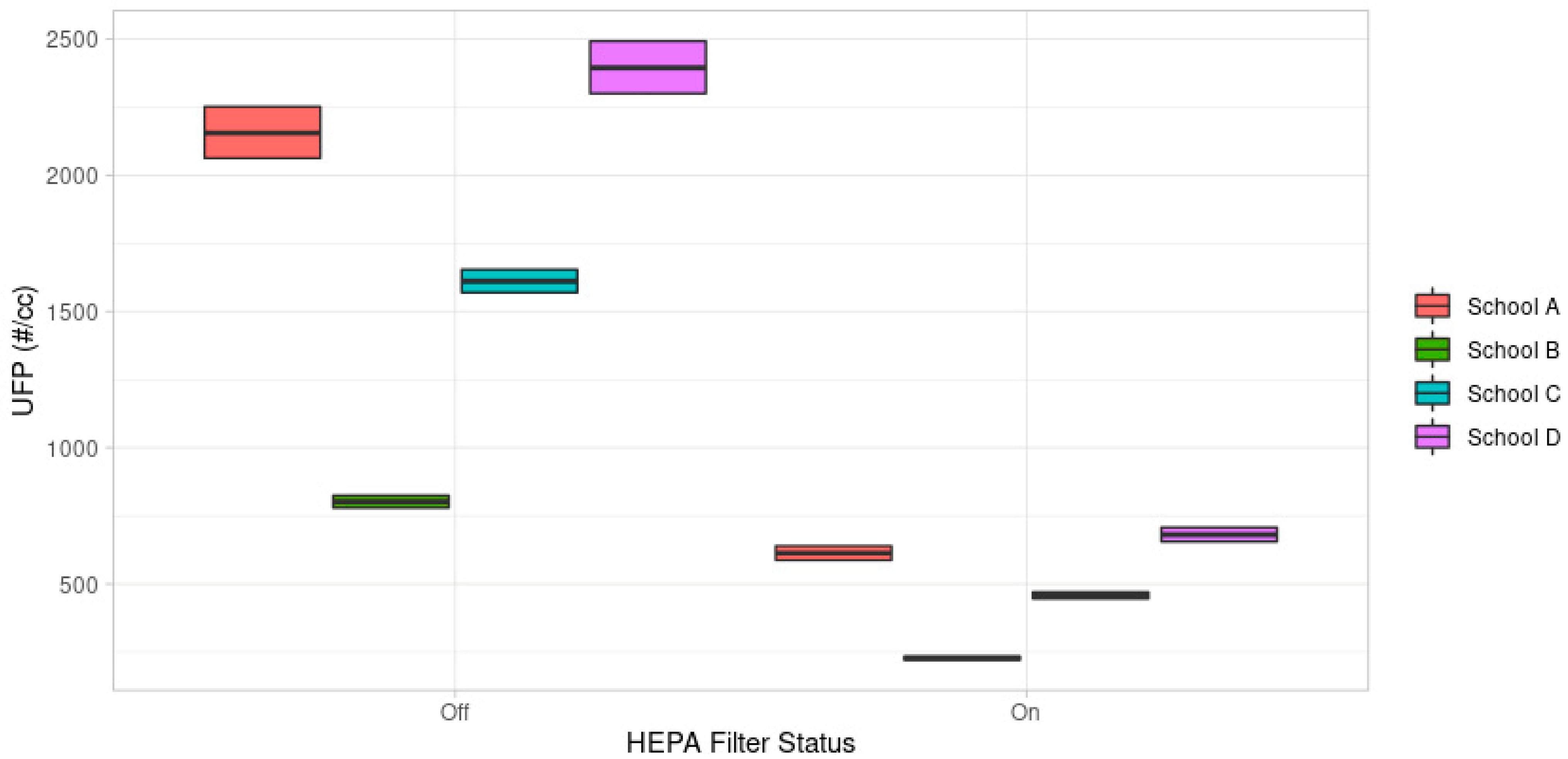
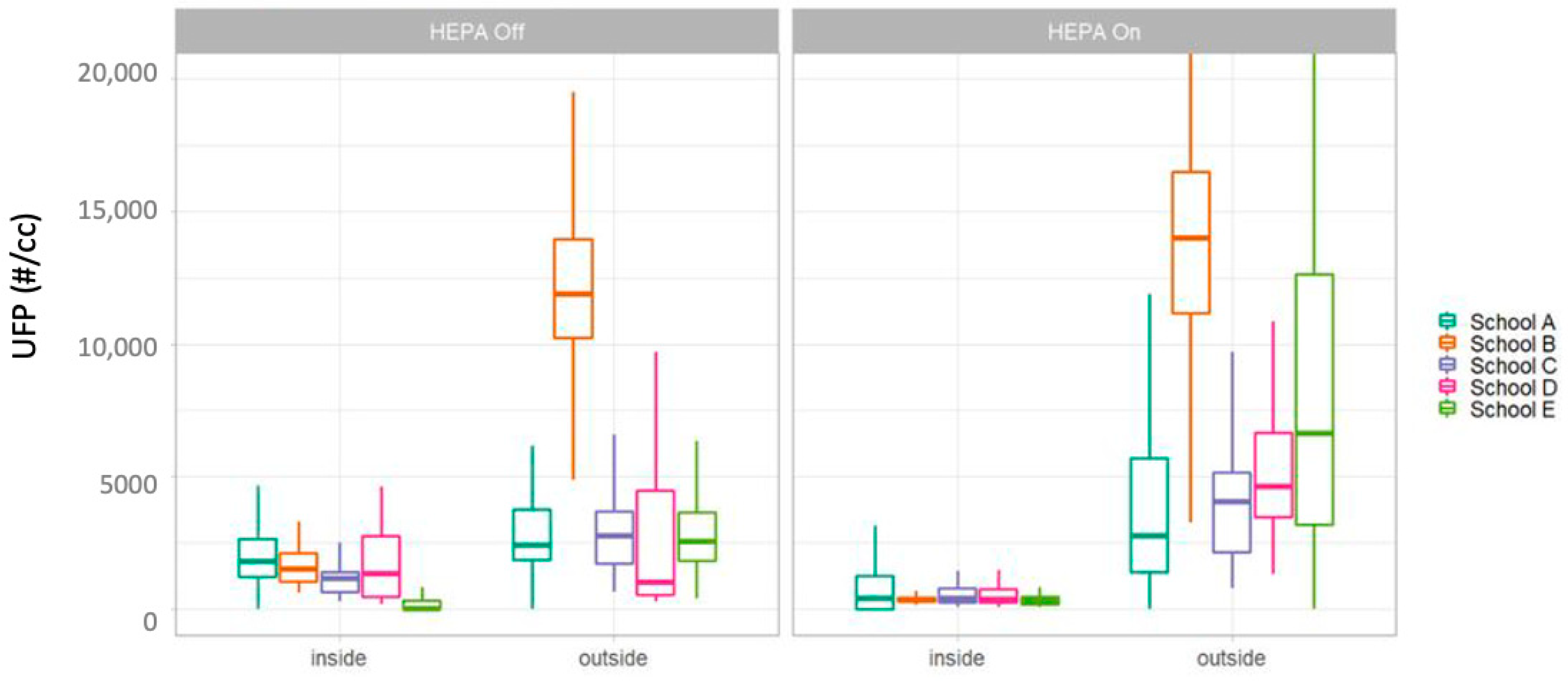
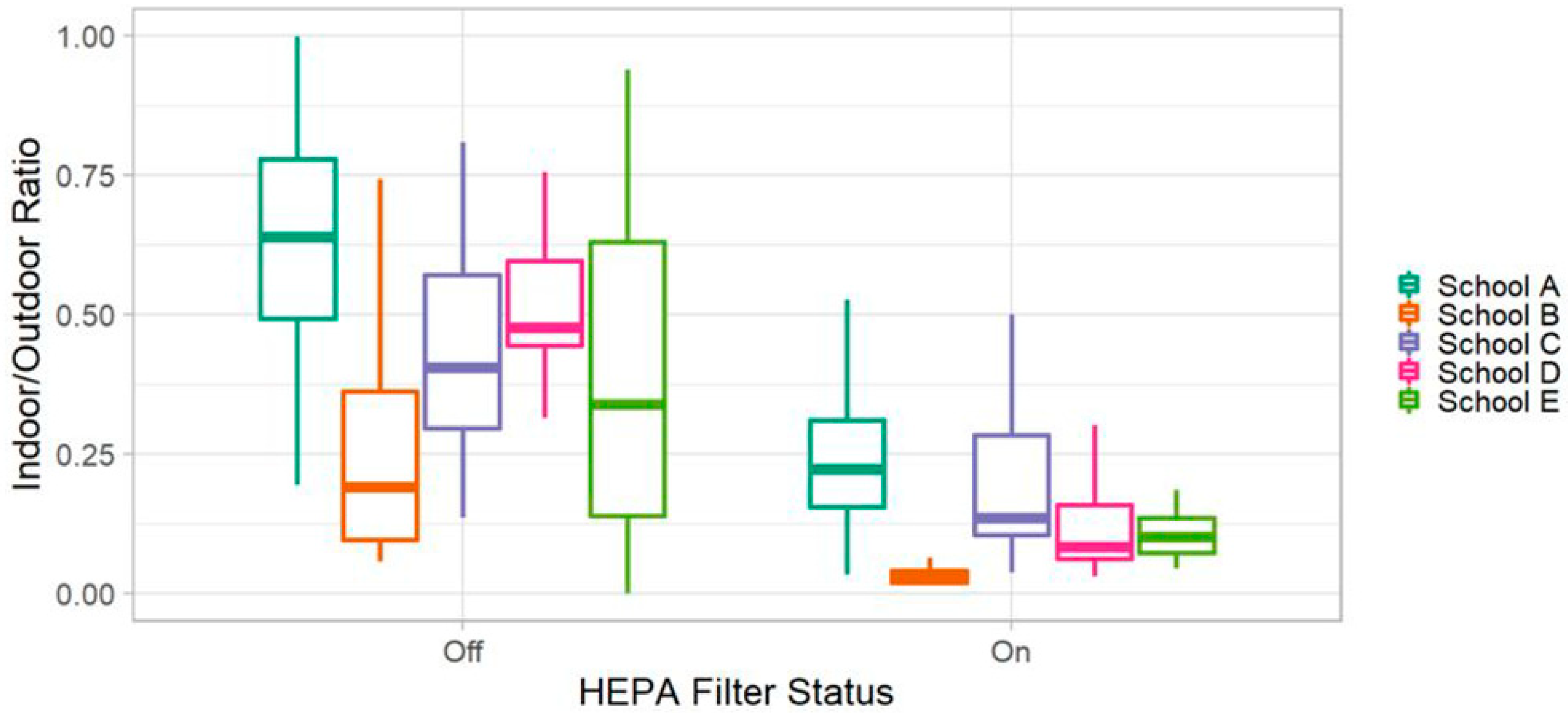
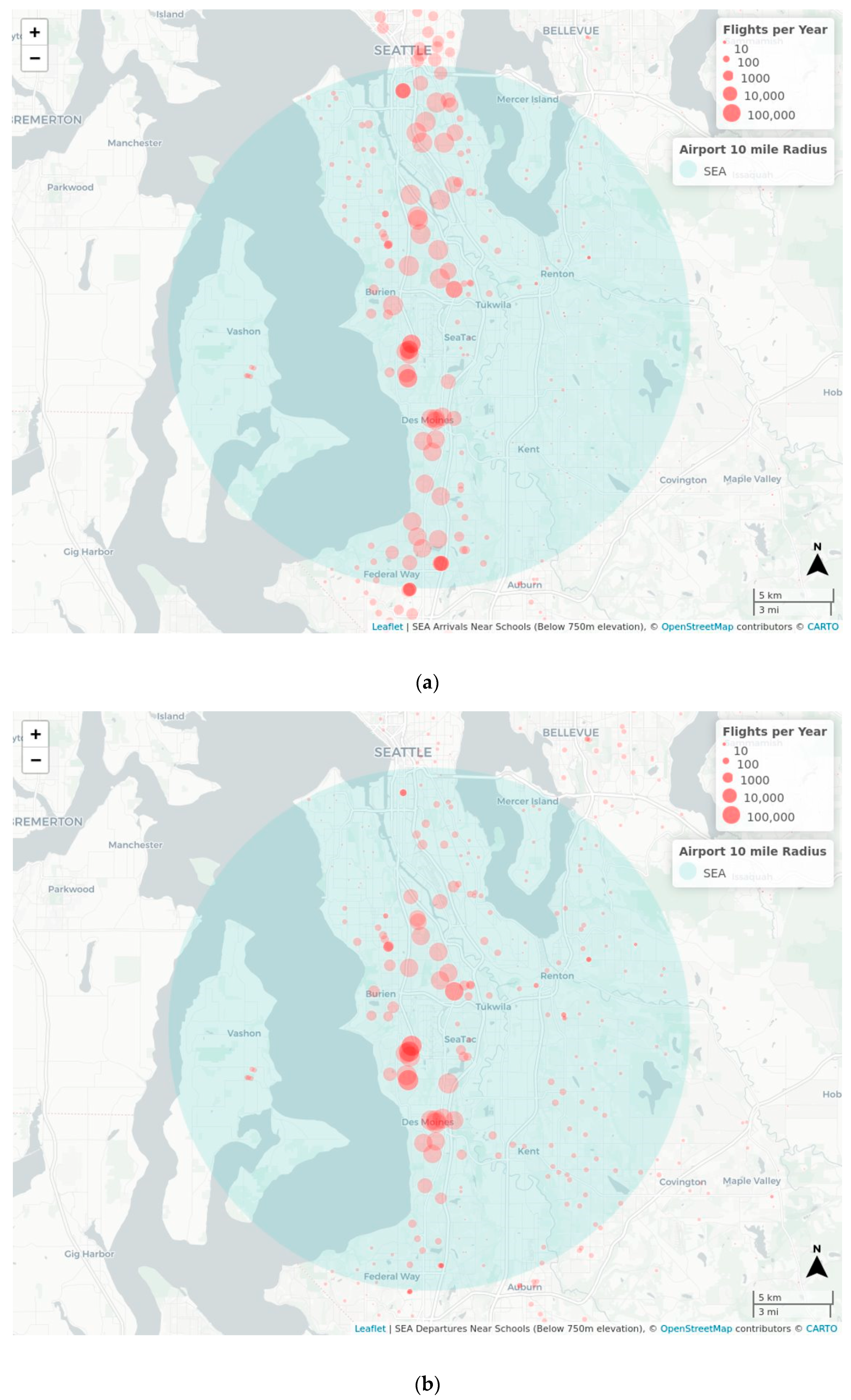
| School | Distance from Airport | Room Area, Full Dimensions (ft) † | Ceiling Height (ft) | Room Volume (ft3) | Room Volume (m3) |
|---|---|---|---|---|---|
| School A 1st flr. | 1.5 miles | 30.2 × 29.2 | 9.9 | 8725.3 | 247.1 |
| School A 2nd flr. | 1.5 miles | 35.0 × 28.0 | 9.9 | 9227.5 | 261.3 |
| School B | 2.1 miles | 32.0 × 28.7 | 9.3 to 12.9 ‡ | 10,053.7 | 284.7 |
| School C | 7.2 miles | 31.8 × 26.5 | 10.4 | 8750.3 | 247.8 |
| School D | 0.5 miles | 31.7 × 23.1 | 9.1 | 6574.7 | 186.2 |
| School E | 5.3 miles | 32.0 × 30.0 | 8.2 | 7840 | 222.0 |
| Parameter | Instrument | Manufacturer | Averaging Time |
|---|---|---|---|
| CO2 | LI-850 CO2 | Li-Cor Biosciences | 10 s |
| Ultra-fine particle size distribution | NanoScan | TSI, Inc. | 1 min (full scan) |
| Particles > 10 nm count | CPC | TSI, Inc. | 10 s |
| Particles > 20 nm count | P-Trak | TSI, Inc. | 10 s |
| Black carbon | MA200 | AethLabs | 10 s |
| Black carbon | AE51 | AethLabs | 10 s |
| Temperature, RH | Hobo sensor | Onset Computer Corp. | 10 s |
| School and Room | First Visit | Sea-Tac Flight Operations | Second Visit | Sea-Tac Flight Operations |
|---|---|---|---|---|
| School A 1st flr. | June 9–11 | Landing | July 26–28 | Take off |
| School A 2nd flr. | June 14–16 | Landing 14th and 15th Take off 16th | July 28–30 | Take off |
| School B | April 14–16 | Take off | July 20–22 | Landing 20th and 21st Take off 22nd |
| School C | April 7–9 | Take off | July 13–15 | Take off |
| School D | June 22–24 | Take off | August 10–12 | Landing |
| School E | March 24–26 | Take off 24th and 26th Landing 25th | July 7–9 | Take off |
| Location | Percent Instrument Error (%) |
|---|---|
| School A Classroom 1, Visit 1 | 0 |
| School A Classroom 1, Visit 2 | 43 |
| School A Classroom 2, Visit 1 | 0 |
| School A Classroom 2, Visit 2 | 33 |
| School B Visit 1 | 0 |
| School B Visit 2 | 27 |
| School C Visit 1 | 0 |
| School C Visit 2 | 0 |
| School D Visit 1 | 0 |
| School D Visit 2 | 0 |
| School E Visit 1 | 19 |
| School E Visit 2 | 0 |
| School | AER Visit 1 | AER Visit 2 |
|---|---|---|
| School A | ||
| Room #1 | 2.1/h | 1.3/h |
| Room #2 | 4.4/h | 1.1/h |
| School B | 0.6/h | 0.9/h |
| School C | 2.2/h | 2.6/h |
| School D | 2.9/h | 0.4/h |
| School E | 1.1/h | 1.1/h |
| Pollutant Type | Infiltration before HEPA | Confidence Range (%) | Infiltration after HEPA | Confidence Range (%) | Removal by HEPA (%) | Confidence Range |
|---|---|---|---|---|---|---|
| Total UFP | 54% | 47–59 | 9% | 8–9 | 83% | 82–84 |
| Aircraft Particles | 41% | 38–56 | 14% | 12–15 | 67% | 67–73 |
| Black Carbon | 74% | 71–79 | 20% | 18–21 | 73% | 73–74 |
| Airport | # Arrivals | # Departures | ||
|---|---|---|---|---|
| Median | (25th–75th Percentile) | Median | (25th–75th Percentile) | |
| Sea-Tac Airport | 3 | (0–36) | 10 | (3–24.75) |
| Boeing Field | 44.5 | (7–232) | 11 | (0–60) |
| Renton Municipal Airport | 0 | (0–1) | 0 | (0–0) |
| All Airports | 102.5 | (18–589) | 35 | (5204.75) |
| Airport | # Arrivals | # Departures | ||
|---|---|---|---|---|
| Median | (25th–75th Percentile) | Median | (25th–75th Percentile) | |
| Sea-Tac Airport | 61,234 | (59,529–154,962) | 53,313 | (6157–55,589) |
| Boeing Field | 18 | (8–89) | 26 | (25–104) |
| Renton Municipal Airport | 0 | (0–0) | 0 | (0–0) |
| All Airports | 61,240 | (59,537–155,094) | 53,547 | (6183–55,693) |
Publisher’s Note: MDPI stays neutral with regard to jurisdictional claims in published maps and institutional affiliations. |
© 2022 by the authors. Licensee MDPI, Basel, Switzerland. This article is an open access article distributed under the terms and conditions of the Creative Commons Attribution (CC BY) license (https://creativecommons.org/licenses/by/4.0/).
Share and Cite
Carmona, N.; Seto, E.; Gould, T.R.; Rasyid, E.; Shirai, J.H.; Cummings, B.; Hayward, L.; Larson, T.V.; Austin, E. Indoor Air Quality Intervention in Schools: Effectiveness of a Portable HEPA Filter Deployment in Five Schools Impacted by Roadway and Aircraft Pollution Sources. Atmosphere 2022, 13, 1623. https://doi.org/10.3390/atmos13101623
Carmona N, Seto E, Gould TR, Rasyid E, Shirai JH, Cummings B, Hayward L, Larson TV, Austin E. Indoor Air Quality Intervention in Schools: Effectiveness of a Portable HEPA Filter Deployment in Five Schools Impacted by Roadway and Aircraft Pollution Sources. Atmosphere. 2022; 13(10):1623. https://doi.org/10.3390/atmos13101623
Chicago/Turabian StyleCarmona, Nancy, Edmund Seto, Timothy R. Gould, Everetta Rasyid, Jeffry H. Shirai, BJ Cummings, Lisa Hayward, Timothy V. Larson, and Elena Austin. 2022. "Indoor Air Quality Intervention in Schools: Effectiveness of a Portable HEPA Filter Deployment in Five Schools Impacted by Roadway and Aircraft Pollution Sources" Atmosphere 13, no. 10: 1623. https://doi.org/10.3390/atmos13101623







